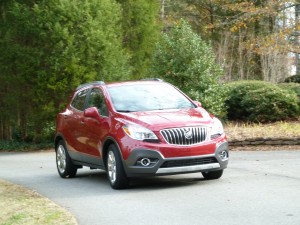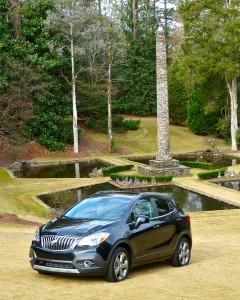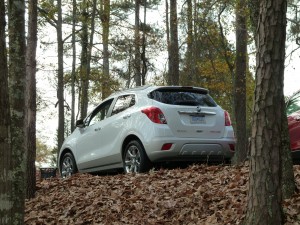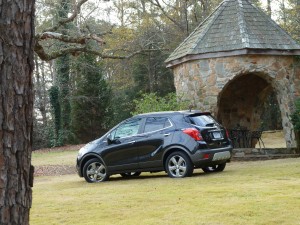Encore becomes perfect encore to Enclave
By John Gilbert
ATLANTA, GA. — To traditional Buick owners, the new Encore might be too small, too light. Traditional Buick cynics might point out the styling glitch of the Encore’s hood having more portholes than there are cylinders. Acknowledging such criticism, the 2013 Encore still might be the ideal vehicle to help Buick continue breaking from its own tradition, in quest of more and younger customers.
The success of the large and luxurious Enclave made us all wonder what Buick could do for an encore, and the response IS the Encore — an all-new compact crossover SUV that is 4 feet shorter and 1,500 pounds lighter than the Enclave, and outperforms it in agility despite having the smallest engine ever offered in any vehicle wearing the Buick name.
Whoever thought we’d see the day when Buick would create a small, compact SUV, powered by a 1.4-liter engine that is turbocharged up to 138 horsepower and 148 foot-pounds of torque, aimed at combining adequate performance plus 30 miles per gallon?
“Basically, the Encore has the attributes of a larger SUV in a smaller, more efficient package,” aid Buick marketing manager Lloyd Biermann. “Our targets are to make this an Enclave for those age 30-50, and come in two primaryu groups — those who are often by themselves in a vehicle and don’t need the room of a bigger SUV, and empty-nesters who don’t need more room for occupants, and who don’t want to be a car-pool person.”
The Encore is truly a global project, with engine ideas springing from Germany’s Opel brand, conceptualized and designed in the U.S., and with actual development and construction done entirely in Gen eral Motors facilities in Korea. James Danahy, who used to be a key engineer on Corvette development, shifted his job to coordinating the development of the Encore, which necessitated him moving to Korea for three years.
The end result is a progressively contemporary and sporty SUV priced from the mid-$20,000 range and aimed at youthful buyers.
Visually, it’s a chopped-off version of the long and flowing Enclave, a bit more blun but retaining the styling flair of its larger sibling, from its waterfall grille on back. “It’s a high-quality, luxurious, small crossover that enhances our appeal and image and gives us the chance to reach to younger buyers,” said Tony Di Salle, Buick vice president of marketing. “Our dealers got a look at it and are asking for six times our projected allotment.”
Buick used to be the wing of General Motors satisfied with making large, squishy-soft sedans to coddle aging buyers. But after GM eliminated Pontiac, Oldsmobile and Saturn, the pressure was on to see if Buick could lower its age demographic and join Chevrolet and Cadillac to lead the corporation’s return to automotive heights. The stylish LaCrosse helped give Buick a large sedan that could bridge the gap from Buick loyalists to a newer breed of domestic near-luxury buyers.
Then came the major breakthrough, when Buick launched a stylish luxury Enclave in 2008, and followed with the Regal, a sharp midsize sedan built on German underpinnings from Opel.The Regal was a major attraction to lure more younger customers, while the Enclave became Buick’s largest seller. Adding the compact Verano, and juicing it up with a turbocharged 2.0-liter engine option helped drop the average age of all Buick buyers by seven years, to 57. In the process, Buick outsold luxury competitors such as Acura, Audi, Infiniti and Lincoln.
At the Los Angeles Auto Show in late November, the Buick display had an Encore or two on stands, but didn’t make a big spectacle of them. A week later, Buick summoned North America’s auto media to Atlanta for the chance to drive the new 2013 Encore. I had the chance to sample both the front-wheel-drive and all-wheel-drive models of the Encore, out of Atlanta and then south and west, to the Chatahoochie River Park.
Both versions met expectations and then some, with the front-driver feeling a little lighter and more agile, but the AWD model feeling a bit more stable and planted in the tight curves of some rural Georgia roadways.
James Danahy, the chief engineer, rode with my co-driver and me on part of the route, and rattled off such features as acoustic glass in the windshield, thicker glass in the side windows, a lot of sound deadening and active noise cancellation, which the Bose audio system can read and offset, plus a 7-inch screen on the center stack that can trace voice-activated commands. A windshield-mounted camera works the lane-departure warning, and the high-fashion interior is enhanced by the Bose premium sound system.
“Purposeful technology,” Danahy called it.
Danahy also spelled out uniqueness of the Encore compared to the Enclave. The Enclave is 201.9 inches long, the Encore 155 inches; Enclave has a 118.9-inch wheelbase, Encore 106; Enclave is 4,724 pounds in FWD form and 4,922 in AWD, Encore is 3,190 in FWD and 3,309 with AWD. The agility of the Encore is defined by its 0.37 coefficient of drag — low for an SUV — and its turning circle of a mere 36.7 feet, which is smaller than a lot of cars.
The five-passenger seating is for a maximum of five in its two rows, while the larger Enclave offers three rows and 7-passenger room in its longer body. The Encore’s rear seat folds down flat, and so does the front passenger seat. The Encore seems larger than its dimensions, and interior roominess is enhanced by 48.4 cubic feet of storage space.
Any of the four Encore models can be bought with all-wheel drive for a price of $1,500. With front-wheel drive, the well-equipped base Encore will start at $25,700, including destination costs. The Encore Convenience upgrade adds dual climate-control and fog-lights at $26,510. Moving up to the Encore Leather adds heated leather seats with memory settings at $28,210. The top Encore Premium loads up with all the other features and adds front and rear park-assist, lane-departure warning, collision alert, and a 7-speaker Bose premium audio, at a price of $29,690.
The soft-touch interior wasn’t enough to satisfy over-zealous Buick designers, who had to put in a little fake woodgrain and bright chrome — a nod to the good ol’ days of Roadmasters, undoubtedly. Stylists also went over the top to integrate another historic Buick touch, putting six portholes on the hood, three on each side. Kind of a nifty idea, because six exhaust portholes bring back the Buick tradition from the old V6 decades; apparently nobody informed the style guys that the Encore will have only a 4-cylinder, so six portholes are silly, symbolic or not.
As light as the Encore is, the 1.4-liter displacement is still small, but adds the benefit of EPA fuel economy estimates of 25 city/33 highway for front-wheel drive, and 23/30 for AWD. Good fuel efficiency wouldn’t matter if the Encore was underpowered, but this 1.4 isn’t. Opel has created the best small-displacement engines in the GM array over the years, and by calling together all its resources, the 1.4 was built with an iron block, aluminum cylinder heads, reinforced crankshaft and forged connecting rods.
The extra zip provided by turbocharging is also evident because while the 138 horsepower peaks at 4,900 RPMs, the 148 foot-pounds of torque rise quickly and maintain that peak from 1,850 to 4,900 RPMs, giving the Encore launching and accelerating punch from barely above idle speed all the way up to the power peak.
Along with its emphasis on quiet luxury, there is more technology under the skin than just the engine. The 6-speed automatic transmission shifts smoothly, and the steering and handling are impressive, with MacPherson strut front suspension, and a torsion beam rear, with stabilizer bars added. Four-wheel disc brakes with antilock and traction-control both standard.
The steering ratio is 16-to-1, and tuned to firm up in feel at highway speed, and the precision of the Encore’s handling is aided by a clever move. Instead of offering the trendy array of various wheel and tire sizes, the Encore comes only with 18-inch wheels, allowing the engineers to focus in on optimum handling control.
“The optional all-wheel drive has a Borg-Warner torque-transfer system,” Danahy explained. “Whenever you stop at a stop sign, it activates the all-wheel drive, and it helps launch and up to 2-4 miles per hour, if there’s no slippage. If you need the traction, it stays in AWD until 37 mph, then if there’s no slipping detected, it transfers to front-wheel drive only.”
More purposeful technology, which will be specially appreciated by those of us who spend a few months living in snow-belt areas. Combine that with its dual personality of enough traditional touches to please old Buick owners and enough pep and fuel economy to impress new buyers, the Encore itself now begs the question: What can Buick do for an encore to the Encore?
Comments
Tell me what you're thinking...
and oh, if you want a pic to show with your comment, go get a gravatar!






 John Gilbert is a lifetime Minnesotan and career journalist, specializing in cars and sports during and since spending 30 years at the Minneapolis Tribune, now the Star Tribune. More recently, he has continued translating the high-tech world of autos and sharing his passionate insights as a freelance writer/photographer/broadcaster. A member of the prestigious North American Car and Truck of the Year jury since 1993. John can be heard Monday-Friday from 9-11am on 610 KDAL(www.kdal610.com) on the "John Gilbert Show," and writes a column in the Duluth Reader.
John Gilbert is a lifetime Minnesotan and career journalist, specializing in cars and sports during and since spending 30 years at the Minneapolis Tribune, now the Star Tribune. More recently, he has continued translating the high-tech world of autos and sharing his passionate insights as a freelance writer/photographer/broadcaster. A member of the prestigious North American Car and Truck of the Year jury since 1993. John can be heard Monday-Friday from 9-11am on 610 KDAL(www.kdal610.com) on the "John Gilbert Show," and writes a column in the Duluth Reader.